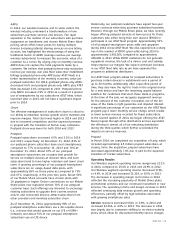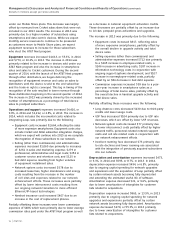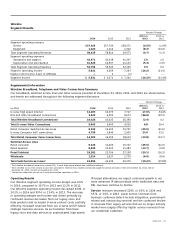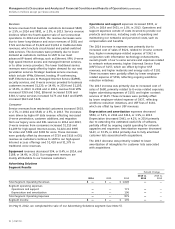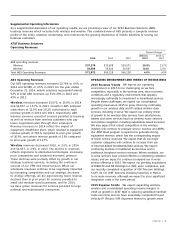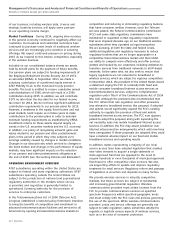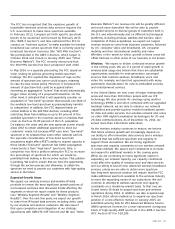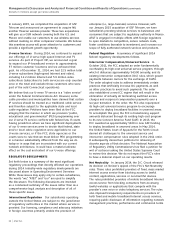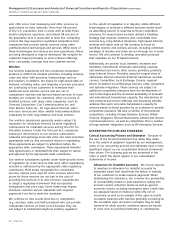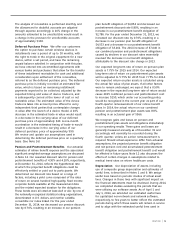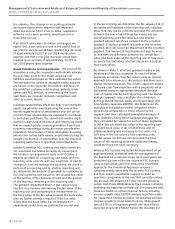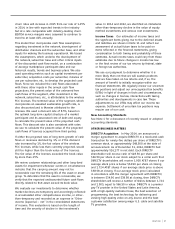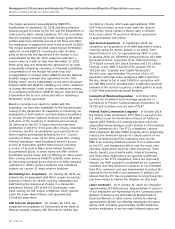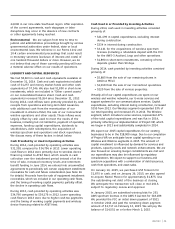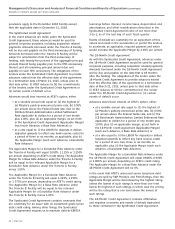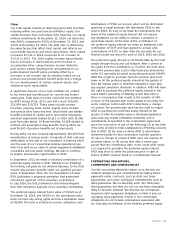AT&T Wireless 2014 Annual Report Download - page 26
Download and view the complete annual report
Please find page 26 of the 2014 AT&T Wireless annual report below. You can navigate through the pages in the report by either clicking on the pages listed below, or by using the keyword search tool below to find specific information within the annual report.
Management’s Discussion and Analysis of Financial Condition and Results of Operations (continued)
Dollars in millions except per share amounts
24
|
AT&T INC.
(or the extent of regulation is in dispute), utilize different
technologies, or promote a different business model (such
as advertising based). In response to these competitive
pressures, for several years we have utilized a bundling
strategy that rewards customers who consolidate their
services (e.g., long-distance telephone, high-speed Internet,
wireless and video) with us. We continue to focus on
bundling wireline and wireless services, including combined
packages of minutes and video service through our U-verse
service. We will continue to develop innovative products
that capitalize on our IP-based network.
Additionally, we provide local, domestic intrastate and
interstate, international wholesale networking capacity,
and switched services to other service providers, primarily
large Internet Service Providers using the largest class of
nationwide Internet networks (Internet backbone), wireless
carriers, Competitive Local Exchange Carriers, regional
phone Incumbent Local Exchange Carriers, cable companies
and systems integrators. These services are subject to
additional competitive pressures from the development of
new technologies and the increased availability of domestic
and international transmission capacity. The introduction of
new products and service offerings and increasing satellite,
wireless, fiber-optic and cable transmission capacity for
services similar to those provided by us continues to provide
competitive pressures. We face a number of international
competitors, including Orange Business Services, British
Telecom, Singapore Telecommunications Limited and Verizon
Communications Inc., as well as competition from a number
of large systems integrators, such as HP Enterprise Services.
ACCOUNTING POLICIES AND STANDARDS
Critical Accounting Policies and Estimates Because of
the size of the financial statement line items they relate
to or the extent of judgment required by our management,
some of our accounting policies and estimates have a more
significant impact on our consolidated financial statements
than others. The following policies are presented in the
order in which the topics appear in our consolidated
statements of income.
Allowance for Doubtful Accounts We record expense
to maintain an allowance for doubtful accounts for
estimated losses that result from the failure or inability
of our customers to make required payments. When
determining the allowance, we consider the probability
of recoverability based on past experience, taking into
account current collection trends as well as general
economic factors, including bankruptcy rates. Credit risks
are assessed based on historical write-offs, net of
recoveries, as well as an analysis of the aged accounts
receivable balances with reserves generally increasing as
the receivable ages. Accounts receivable may be fully
reserved for when specific collection issues are known
to exist, such as pending bankruptcy or catastrophes.
who offer voice, text messaging and other services as
applications on data networks. More than 98 percent
of the U.S. population lives in areas with at least three
mobile telephone operators, and almost 94 percent of
the population lives in areas with at least four competing
carriers. We may experience significant competition from
companies that provide similar services using other
communications technologies and services. While some of
these technologies and services are now operational, others
are being developed or may be developed. We compete for
customers based principally on service/device offerings,
price, call quality, coverage area and customer service.
Wireline
Our wireline subsidiaries will face continued competitive
pressure in 2015 from multiple providers, including wireless,
cable and other VoIP providers, interexchange carriers
and resellers. In addition, the desire for high-speed data on
demand, including video, and lingering economic pressures
are continuing to lead customers to terminate their
traditional local wireline service and use our or
competitors’ wireless and Internet-based services. In most
markets, we compete for customers, often on pricing of
bundled services, with large cable companies, such as
Comcast Corporation, Cox Communications Inc. and
Time Warner Cable Inc., for high-speed Internet, video
and voice services and other smaller telecommunications
companies for both long-distance and local services.
Our wireline subsidiaries generally remain subject to
regulation for wholesale services by state regulatory
commissions for intrastate services and by the FCC for
interstate services. Under the Telecom Act, companies
seeking to interconnect to our wireline subsidiaries’
networks and exchange local calls enter into interconnection
agreements with us. Any unresolved issues in negotiating
those agreements are subject to arbitration before the
appropriate state commission. These agreements (whether
fully agreed-upon or arbitrated) are then subject to review
and approval by the appropriate state commission.
Our wireline subsidiaries operate under state-specific forms
of regulation for retail services that were either legislatively
enacted or authorized by the appropriate state regulatory
commission. Most states deregulate the competitive
services; impose price caps for some services where the
prices for these services are not tied to the cost of
providing the services or to rate-of-return requirements;
or adopt a regulatory framework that incorporates
deregulation and price caps. Some states may impose
minimum customer service standards with required
payments if we fail to meet the standards.
We continue to lose access lines due to competitors
(e.g., wireless, cable and VoIP providers) who can provide
comparable services at lower prices because they are
not subject to traditional telephone industry regulation



